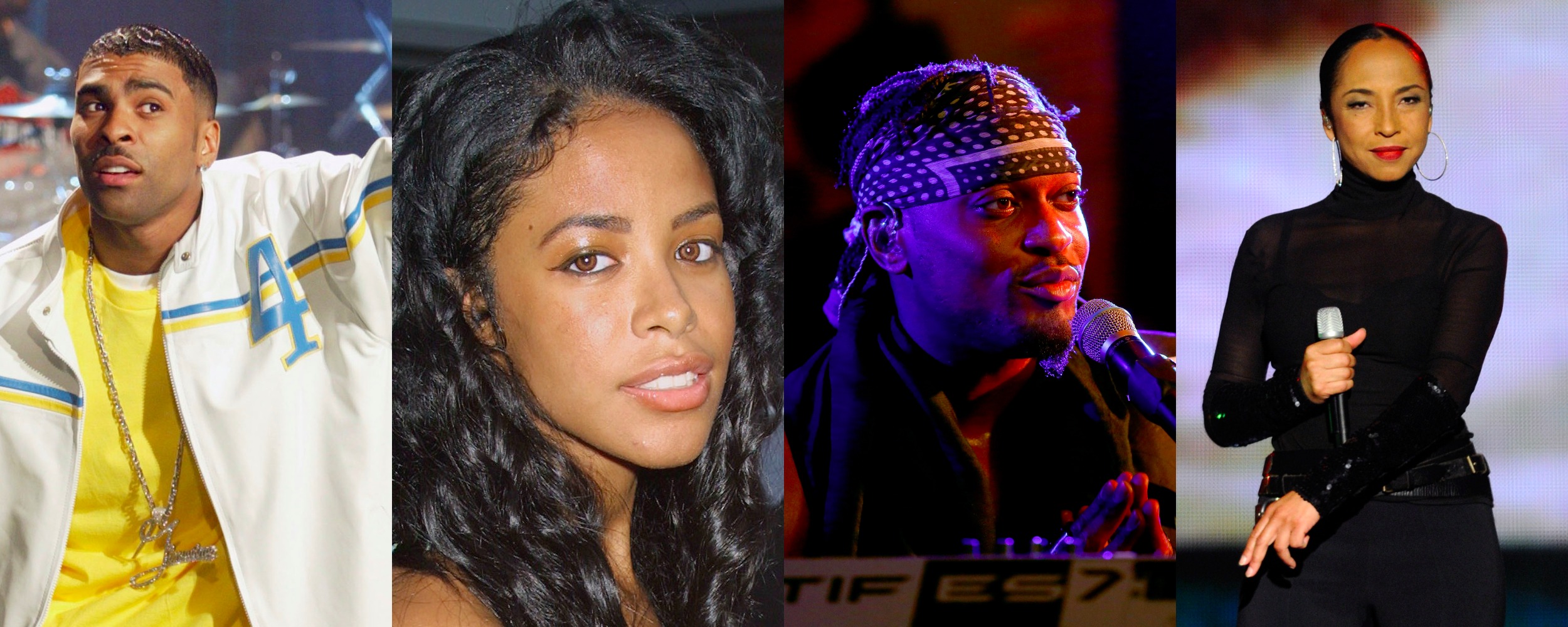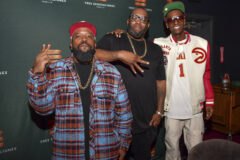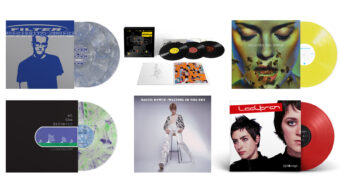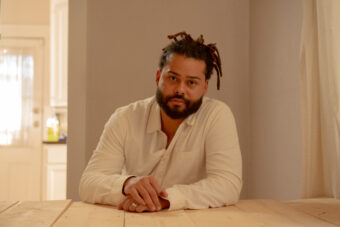The ‘90s may be the last decade when R&B, not hip-hop, was the dominant force in black music. Innovation abounded, with New Jack Swing giving way to neo-soul as well as further experiments with studio technology’s fast-moving innovations. R&B crossover was a matter of course on the pop charts; there, ballads like Whitney Houston’s blockbuster “I Will Always Love You” and the stirring Boyz II Men–Mariah Carey team-up “One Sweet Day” had months-long reigns at No. 1, while upbeat tracks like Blackstreet’s swaggering “No Diggity” and Janet Jackson’s peppy “Together Again” also reached the summit.
Artists from every echelon and subgenre seemed to be laser-focused on honing and upping their game: ‘80s titans like Jackson and her brother Michael incorporated of-the-moment ideas into their platinum-plated ‘90s work; early-decade upstarts like Mariah Carey and TLC blossomed into megastars, forcing pop listeners to keep up their ever-evolving visions for the genre; and new acts like Maxwell and Lauryn Hill emerged in constant states of evolution, redrawing R&B’s boundaries so that the genre encompassed ever-greater territory. These 30 highlights from the decade collect some of R&B’s highest points.
30. Prince and the New Power Generation, ”Diamonds & Pearls” (1991)
Prince experienced a lot of transitions in the ‘90s—his name change to a symbol, his acrimonious departure from Warner Bros. Records, his transition to independence, his pioneering forays into online retail. But he opened the decade with this gorgeous, glittering expression of pure love, his restrained vocal given a counterpoint by New Power Generation member Rosie Gaines, whose unbridled performance crests on the track’s show-stopping bridge. –Maura Johnston
29. Babyface, “When Can I See You” (1994)
Released in 1994 during the MTV Unplugged era, this acoustic gem revealed new depth for a songwriter who was often (unfairly) accused of being somewhat formulaic. Kenneth Edmonds’ forthright and unadorned ballad led to a brief spike in acoustic soul (see The Tony Rich Project’s “Nobody Knows”) and seemed to predict the rise of neo-soul as well. –Mosi Reeves
28. Toni Braxton, “You’re Makin’ Me High” (1996)
The slinky lead single from Braxton’s 1996 mega-seller Secrets simmered, with Braxton’s vocal performance doubling as an exquisite lesson in self-control—which, it turned out, was right in line with the chart-topping track’s ethos. “That’s what ‘You’re Makin’ Me High’ was all about,” she told the London Independent in 1996, when they inquired after the Babyface/Bryce Wilson co-production’s subject matter. “Masturbation. It’s a very safe form of sex.” –MJ
27. Maxwell, “Luxury: Cococure” (1998)
Maxwell debuted in 1996 with a mix of D’Angelo’s enigmatic funk and Sade’s airy, slightly remote soul-jazz. But he soon evolved into a remarkably unique performer by stretching neo-soul to its ambient limits, and using abstract images to anchor his songs of love, faith, and heartbreak. Critics initially misinterpreted “Luxury: Cococure,” the first single from Embrya, as a pretentious mess rather than a soul analog to hypnagogic pop icons like Björk. Amidst lush sounds, Maxwell compares the newness of black love to submerging himself in deep waters. He feels cocooned by the sensation, even as the freezing water saps his energy, much like the protagonist in Kate Bush’s orchestral suite “The Ninth Wave” (from her Hounds of Love). It’s heady, intellectual fare for an audience used to savoring his ballads through Urban Adult Contemporary radio, and despite early trepidation, they embraced his conceits wholeheartedly. –MR
26. Whitney Houston, “Heartbreak Hotel” (1998)
By 1998 and My Love is Your Love, Whitney Houston was as well known for her tabloid exploits with Bobby Brown as she was for her legendary pop career. The great thing about “Heartbreak Hotel,” the lead single from her last great album, was that it reminded listeners that Houston’s musical art, not her Hollywood blockbusters and People magazine headlines, was most important. It marked a passing of the torch to a younger generation of black women, represented by Faith Evans and Kelly Price; the trio’s carefully restrained yet anguished vocals, set amidst a stutter-step bounce and cameos from Faith Evans and Kelly Price, felt like a remarkable achievement. –MR
25. Mark Morrison, “Return of the Mack” (1996)
Seemingly emerging from out of nowhere, this British one-hit-wonder made one of the most memorable hooks of the decade. (Some have called it the best song ever, but we wouldn’t go that far.) It’s so killer, in fact, that it essentially overwhelms his lyric about going back on the market after his woman cheats on him. “Return of the Mack” is less about recovering from a breakup than reasserting your pride, no matter how damaged. Basically, it’s an excuse to harmonize “Return of the mack!” again and again. –MR
24. Mint Condition, “Breakin’ My Heart (Pretty Brown Eyes)” (1991)
The lush, sprawling ballad from Mint Condition’s 1991 debut Meant to be Mint isn’t only an exquisite expression of how love (or, at least, infatuation) can rip one’s heart in two; it showcases the sextet’s chemistry and talent for pacing, with its nearly six-minute length almost feeling a shade too short thanks to its smouldering build and Stokley Williams’ song-ending leave-it-in-the-booth ad-lib. –MJ
23. Groove Theory, “Tell Me” (1995)
Amel Larrieux and Bryce Wilson’s debut single arrived during a fortuitous moment. Though still a viable force, acid jazz and house music had waned in the black mainstream, and neo-soul authenticity had emerged as a potential new force. “Tell Me” alluded to all these sounds with its stride piano, a steadily pulsing beat, and Larrieux’s aching falsetto voice. It seemed to portend Groove Theory as a new innovator in R&B. Instead, the duo disbanded shortly after its release, leaving fans of the Billboard top 10 single to wonder what could have been. –MR
22. Michael Jackson, “Remember the Time” (1992)
When the second single from Michael Jackson’s New Jack-embracing Dangerous initially came out, most of the attention went to its audacious, cameo-studded video, which was directed by John Singleton and featured the Gloved One’s first on-screen kiss (with Iman, who played an ennui-ridden queen). But the song—co-written by New Jack Swing architect Teddy Riley and his collaborator Bernard Belle along with Jackson—hits the exact sweet spot of Jackson’s appeal, blending of-the-moment pop aesthetics with a feather-light funkiness and one of Jackson’s most unbridled vocal breakdowns. –MJ
21. Xscape, “Just Kickin’ It” (1993)
After the release of Dr. Dre’s The Chronic, R&B briefly swelled with acts that tried to replicate its unhurried lowrider tempo and neo-Blaxploitation funk. (Also see Color Me Badd’s “Time and Chance,” Janet Jackson’s “Any Time, Any Place (R. Kelly Mix),” and Sweet Sable’s “Old Times Sake.”) But Xscape’s debut single was arguably the best. The four Atlanta women brought lovely multi-part harmony to their vision of teenage love, a home-cooked meal and chilling on the avenue. Despite a brief interlude that this was “strictly for the niggas,” it sounded as universal as anything on the charts in 1994. –MR
20. SWV, “Right Here (Human Nature)” (1992)
In its original form on SWV’s 1992 debut It’s About Time, “Right Here” was a sad-yet-upbeat New Jill Swing jam that recalled TLC’s “Aint 2 Proud 2 Beg” and other similarly feisty R&B, right down to the rapped bridge; the group’s first single, it hit No. 13 on the R&B chart. Megaproducer Teddy Riley decided to rework the track for the Free Willy soundtrack, front-loading the group’s silky harmonies and taking the tempo down a notch while—most crucially—adding a dreamy bit from Michael Jackson’s Quiet Storm smash “Human Nature” that gave the ladies a countermelody to push against vocally. (A young Pharrell Williams is also in the mix, careening around the track while spelling out the group’s acronym.) While the remix has become a touchstone for producers who want to incorporate old-school sounds into modern-day singles, SWV admitted in 2014 that they were initially cool on it: ”We hated that song! We thought it was going to mess up our career,” Coko said on Sway in the Morning in 2014. But, she added, “we were wrong many times.” –MJ
19. Brandy, “I Wanna Be Down” (1994)
Brandy Norwood was 15 when she released this ode to secret crushes. Produced by gospel legend Andrae Crouch’s nephew Keith Crouch with a soft funky worm melody, “I Wanna Be Down” was as innocent as dropping your schoolbooks in the hallway to attract a boy’s eye. Brandy sounded her age, even though she sang with a gentle tone that could rise to a sharp, gospel-trained gale in a matter of seconds. It was clear that Brandy was preternaturally talented, and “I Wanna Be Down” was the first of many hits to come. –MR
18. Ghost Town DJ’s, “My Boo” (1996)
Every so often, a pop artists will start and finish on top, and that’s exactly what the Atlanta hip-hop collective Ghost Town DJ’s did with their 1996 single “My Boo,” which combined the heavy yet fleet rhythms of Miami bass with a sweet street-corner vocal from Virgo Williams, whose giddy vocal performance embodies infatuation—and also makes “My Boo” a top-notch rollerskating jam, one that seems to float by even as it engages in fancy footwork. –MJ (Read SPIN’s oral history of “My Boo” here.)
17. Boyz II Men, “End of the Road” (1992)
If Boyz II Men’s debut single “Motownphilly” announced them as inheritors of the New Edition’s hot dance floor hits, then “End of the Road” showed they were more than a New Jack flash-in-the-pan. In those days, R&B acts proved their talent through ballads, and this expertly rendered tale of a breakup that shouldn’t, can’t happen demonstrated that the four men were incredible singers, and perhaps the best of their generation. Boyz II Men may have eventually been overshadowed by other male crews – as Andre Harrell once said, folks liked Boyz II Men, but they LOVED Jodeci. But as “End of the Road” became a signature song for a generation on the cusp of adulthood and leaving their teenage friendships behind, it was clear that folks have plenty of love for Boyz II Men, too. –MR
16. R. Kelly, “Bump ‘N Grind” (1994)
These days, it’s hard to separate the onetime king of R&B from numerous allegations of him preying on young and underage women. R. Kelly’s reputation may be at justifiably low ebb, but as the defining male vocalist of ‘90s black music, it’s impossible to not include him here. In retrospect, “Bump ‘N Grind” predicted many of the problems that he now faces: it equates the power of lust as an overwhelming, unstoppable force that neither society nor morality can stop. “My mind is telling me no, but my body’s telling me yes!” he cries with gospel fervor. Coupled with a remarkable talent for writing and producing songs, Kelly’s raw and unrepentant sexual persona once seemed modern and something to embrace, instead of a dangerous illusion to be questioned and ultimately rejected. –MR
15. Sade, “No Ordinary Love” (1992)
The smooth-operator gloss of Sade Adu and her namesake band get mussed on this intense, winding single from 1992’s Love Deluxe. Adu’s ruptured cool gives this glowering track’s brokenhearted lyrics a desperate edge, while the churning guitars submerged in the song’s middle add to the overall emotional turmoil, which barely subsides even as the song fades out. A crushing portrait of trying to keep it together and almost succeeding. –MJ
14. Brandy & Monica, “The Boy is Mine” (1998)
While this R&B megahit originally grew out of Brandy being inspired by The Jerry Springer Show’s furniture-flinging fights, what set it apart from the era’s more clamorous pop was the minor-key seethe of Monica incredibly tense vocal performances and the sumptuous, string-laden production by Rodney “Darkchild” Jerkins. Its bubbling synths and sinewy vocal melodies made it the No. 1 song for 1998’s almost-entire summer, an appropriate season for a song that sounds milliseconds away from boiling over. –MJ
13. Mariah Carey, “Fantasy” (1995)
Mariah Carey’s foray into hip-hop on her 1995 album Daydream peaked with this giddy track. “Fantasy” amps up the romantic bliss of Tom Tom Club’s 1981 hybridized underground hit “Genius of Love,” flipping that track’s squiggle-synths into a bubblegum pop track that could double as a launching pad for Carey’s skyscraping voice—and a verse by the Wu-Tang Clan firebrand Ol’ Dirty Bastard, who popped up on the song’s remix and in the amusement-park-themed video. Carey would return to the “surprising old-school sample + Mariah = pop gold” formula a few times in the ensuing years, but “Fantasy” set the standard. –MJ
12. Blackstreet, “No Diggity” (1996)
East Coast met West Coast on this collaboration between Teddy Riley’s crew and post-Death Row Dr. Dre, and “No Diggity” sounds like a goofy, funky romp. It’s essentially an appreciation of how a woman “works it,” and that’s it. The group members initially resisted recording it because the premise is so slight. But that’s what makes it great. It has a sticky chorus that nudges in your memory even if you don’t want it there, and Riley and Skylz Stewart’s slick, piano-laden rhythm (inspired in part by the RZA’s Wu-Tang Clan ethos) sounds like money. True, “No Diggity” is kinda annoying, too – that’s what happens when a hit single is made into a Hanes underwear commercial. Yet who hasn’t bopped along to this one? No diggity. —MR
11. Ginuwine, “Pony” (1996)
Zapp and Roger’s “Computer Love,” Ginuwine’s “Pony,” and T-Pain’s “I’m Sprung”: These are the moments that shocked listeners and musicians alike into a new way of thinking about soul music. Timbaland’s first major hit sounded like a junkyard of electronic bleeps and thumps, and he weaved his baritone vocalese into the rhythm as if he was an instrument himself. Ginuwine rode the beat with a grinding, brazenly sexual performance; it’s hard not to miss the metaphor at the heart of this. Timbaland would arguably reach greater heights with Aaliyah and Missy Elliott, but for those who remember hearing “Pony” for the first time in 1996, it’s an experience they’ll never forget. –MR
10. Jodeci, “Forever My Lady” (1991)
When Jodeci debuted in 1991, it still seemed possible to reconcile vocal ensembles with hip-hop machismo. Today, it appears that effort has failed – save for aging troupes like After 7 and Jagged Edge, R&B male groups are virtually extinct. But there was a time when every singer modeled himself after K-Ci Hailey, the Southern bad boy whose rough, Bobby Womack-inspired growl (along with his talented but less iconoclastic brother JoJo Hailey) turned Jodeci into the prototypical black group of the ‘90s. He adds so much heat to “Forever My Lady” that it threatens to boil; it feels like a bedroom jam of the most sensational kind, even though it’s about becoming a father for the first time. Admirably, Jodeci could sing about monogamous relationships with as much passion as they do with sex-drenched late nights. Few R&B men have lived up to their example. —MR
9. Erykah Badu, “On & On” (1996)
It may have been her presence more than her music that startled in 1997. Badu was a black woman clothed in a sarong and a head wrap, singing Five Percent Nation quotes in a style reminiscent of Billie Holiday over a sticky, churning neo-soul rhythm. That last element wasn’t so new – Anita Baker is just one of many modern R&B singers who thrived in a jazz element – but Badu’s approach seemed fresh and groundbreaking. “On & On” sounds like she’s exploring the mysteries of life, which isn’t the usual fodder for pop radio, and as she heads into the unknown, we want to follow her. –MR
8. Bell Biv DeVoe, “Poison” (1990)
By 1990, Bell Biv DeVoe evolved into a prototype for Wu-Tang Clan, with all past and present members enjoying wildly successful solo albums. But only one track from that era can still set off any dance floor like a Christmas tree. “Poison” is a burst of energy, from DJ Freeze’s staccato keyboards (which he later said was his version of Kraftwerk mixed with Latin salsa) to a sample of Kool G Rap being punched in like a shot across the bow. The lyrics are purely louche, three guys so mad at a former girl that they dog her out on wax. “Yeah, Cool used to do her,” drawls Ronnie Devoe in apparent reference to Bobby “Cool” Brown. Is this what hip-hop on the R&B tip with a pop appeal to it means – an exercise in slut-shaming? Who cares? The song is hot. –MR
7. Lauryn Hill, “Ex-Factor” (1998)
Lauryn Hill’s solo debut The Miseducation of Lauryn Hill sent shockwaves through the industry, its exquisitely produced fusions of hip-hop, R&B, reggae, and whatever other genres captured the former Fugee’s fancy, breaking sales records and uniting critics with lay listeners. The brutal close-up of relationships’ mutual failings “Ex-Factor” was reportedly written for a girl group of the same name, but Hill kept it for herself after deeming its lyrics (allegedly aimed at her former bandmate Wyclef Jean) too personal; her wrenching performance makes it clear that her decision was absolutely correct. –MJ
6. Janet Jackson, “That’s the Way Love Goes” (1993)
The lead single from 1993’s janet. sampled James Brown and “Impeach the President,” but its funk was of a more laid-back variety; with her longtime collaborators Jimmy Jam and Terry Lewis, Janet Jackson created a stretched-out tableau of flinty guitars and laconic rhythms, over which she matter-of-factly murmured double-entendre come-ons. It existed in a place far from the rhythm nation she’d commandeered on her previous album, but it was no less exciting. –MJ
5. TLC, “No Scrubs” (1999)
TLC’s trajectory over their first decade—a hot debut accompanied by hotter gossip, and followed up by a second full-length that spawned massive singles while being accompanied by a bankruptcy filing and other industry woes—peaked with this 1999 broadside against men who can’t hold up their end of the relationship bargain. The song itself was impossibly chill, with Rozonda “Chilli” Thomas’ pointed evisceration of broke-ass dudes serving as a counterpoint to its glittery guitars and satisfying most of the song’s burn quotient (Lisa “Left Eye” Lopes’ rejection of those who “can’t spatially expand my horizon” filled out the rest). “No Scrubs” was so potent that it spawned a rare-for-the-’90s reaction single, “No Pigeonz,” from the New York duo Sporty Theivz; that its lumbering sneers hardly measured up to the original proved T-Boz, Chilli, and Left Eye’s point twice over. –MJ
4. En Vogue, “Hold On” (1990)
En Vogue is the modern girl group, the ones who inspired Total, Destiny’s Child, Brownstone, and the last great wave of sisters with voices in the ‘90s. (Credit is also due to ‘80s Latin freestyle groups like Exposé and The Cover Girls.) The Oakland quartet’s classic debut alludes to The Miracles (by way of The Jackson 5) chestnut “Who’s Lovin’ You,” then flashes the same rich four-part melodies during a tale of love squandered and lost. “Ooh, my first mistake was, I wanted too much time/I had to have him morning, noon, and night,” sings Cindy Herron. Producers Foster & McElroy deliver a slow-burning rhythm with a James Brown drum kick, but “Hold On’s” greatest element is Herron, Terry Ellis, Dawn Robinson, and Maxine Jones blending their voices into a sound that shifts the culture. –MR
3. D’Angelo, “Brown Sugar” (1995)
Neo-soul has many mothers and fathers, including Meshell Ndegeocello, Brand New Heavies, and Joi Gilliam. But the first time the audience knew that a new form of soul music had emerged was when D’Angelo’s debut single crept into BET’s video shows in the spring of 1995. The song is all Rhodes organ and soul-jazz vibes, and D’Angelo sings in a low, muted drawl that sounds heavily medicated. He could be singing about chocolate thai, or a fine woman that makes him “don’t know how to behave.” Basically, he sounds cool as shit, as if Snoop Dogg was doing a set with Cannonball Adderley. D’Angelo’s emergence as the baddest player in R&B masked his deep knowledge of black music idioms, which he’d reveal on his debut album and other works to come. We’d soon realize that it takes a lot of ingredients to make a song as deep as “Brown Sugar.” –MR
2. Mary J. Blige, “Be Happy” (1994)
Much of Mary J Blige’s best work blends the bitter and sweet notes of love and life, but none with as much pain and much-needed catharsis as “Be Happy.” The opening track from My Life begins with one of the great opening lines in contemporary R&B: “How can I love somebody else/If I can’t love myself to know/When it’s time/Time to let go?” Critics at the time unfavorably contrasted her melancholy tone with the hopeful sound of her equally memorable debut What’s the 411?, resulting in the “sad Mary” stereotype that has stuck with her to this day. But the uneasy quality resonated with audiences, and today it’s considered her most essential work. From Sean “Puffy” Combs and Poke’s Curtis Mayfield loop, to the yearning in Blige’s voice, “Be Happy” epitomizes soul music as personal and spiritual epiphany. When she sings, “All I really want is for me to be happy,” she could be talking about all of us. –MR
1. Aaliyah, “Are You That Somebody?” (1998)
The greatest R&B song of the ‘90s was the result of incredible urgency: In 1998 Timbaland and Steve “Static Major” Garrett got the call to craft a track for R&B thrush Aaliyah, who’d been asked to sing a track for Eddie Murphy’s big-screen Dr. Doolittle adaptation. To hear Timbaland tell it, the track came together quickly: Tim crafted the booming, stuttering beat, Static unearthed the hook, and Tim added the cherry on top: a sample of a cooing baby (from crate-digging that came up with “Countdown to 6,” a 1968 track by analog synth wizards Jean-Jacques Perrey and Gershon Kingsley). Aaliyah’s expressive vocal—which shows off the might of her powerful instrument and ability to not only keep up with, but dart around, Timbaland and Static’s start-stop rhythms schemes—remains cucumber-cool throughout, with the baby’s delight serving as a tell for the thrill offered by the song’s futuristic visions. –MJ





